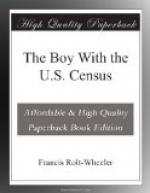“It wasn’t so awful bad,” said the woman, with a sigh of relief.
“It’s easy enough to answer census questions when you want to make it easy and tell a straight story,” Hamilton replied, “but you see what trouble it would be for me with some one who wasn’t willing to talk, and how hard it would be for any one to make up a story as he went along, and find it tally at every point in all the later questions.”
“Well, sah,” she called, in reply, as the lad passed out, “Ah jes’ hope yo’ don’ fin’ a single one like that in this hyar whole village.”
“I hope not, Lily. Good-morning,” he rejoined and turned toward the next house.
The enumeration of the rest of the village went on rapidly. By working quickly Hamilton was able to complete the numbering of the village by nightfall, and he so stated on his daily report card, which he mailed to the supervisor that evening.
The following morning he started off on his little mare, and struck something new and puzzling at every holding he touched. The agricultural schedule fairly made his head swim. It had certain difficulties which the manufacturing schedule did not have, because, although the latter contained more detailed information and required a more accurate statement, still all manufacturers kept books. For the details needed in the agricultural statistics no books had been kept; the negro farmer seldom or never knew how many chickens he had, and the wild guesses that would be made as to value of animals and land nearly turned the boy’s hair gray. Some of the white farmers were every bit as careless, one man valuing his horses at $200 apiece and the next at $50; one man estimating his land at $150 an acre and the next at $10.
A typical case was that of Patrick Meacham. Hamilton secured the facts for his population schedule with comparatively little trouble from the Meacham household, although he had to listen to a great deal of unnecessary family history. There was no great difficulty, moreover, in finding out that the farm consisted of 80 acres owned and 10 rented, but a snag of the first magnitude was encountered on the question as to how much of it was improved.
“Sure, ’tis all improved,” the farmer said; “it was in horrible shape whin I bought it.”
“I don’t mean improved that way,” Hamilton objected, “what I want to know is how much of it is good for pasture, is prepared for crops, and so forth.”
“Sure, it’s all good for somethin’,” the Irishman answered; “what for should I buy it if it wasn’t good for anythin"?”
“Have you a wood-lot?” asked Hamilton, deciding to try and get at the question in another way.
“I have a wood-lot. But I built a good strong fence around it, since I came here,—ye don’t mean to tell me that doesn’t improve it? If ye lived here, ye’d know better.”
“That’s all right, Mr. Meacham, it makes it better all right, but it isn’t counted in as ‘improved land.’ I’ll put it down specially though. There’s ten acres of it, you said.”




